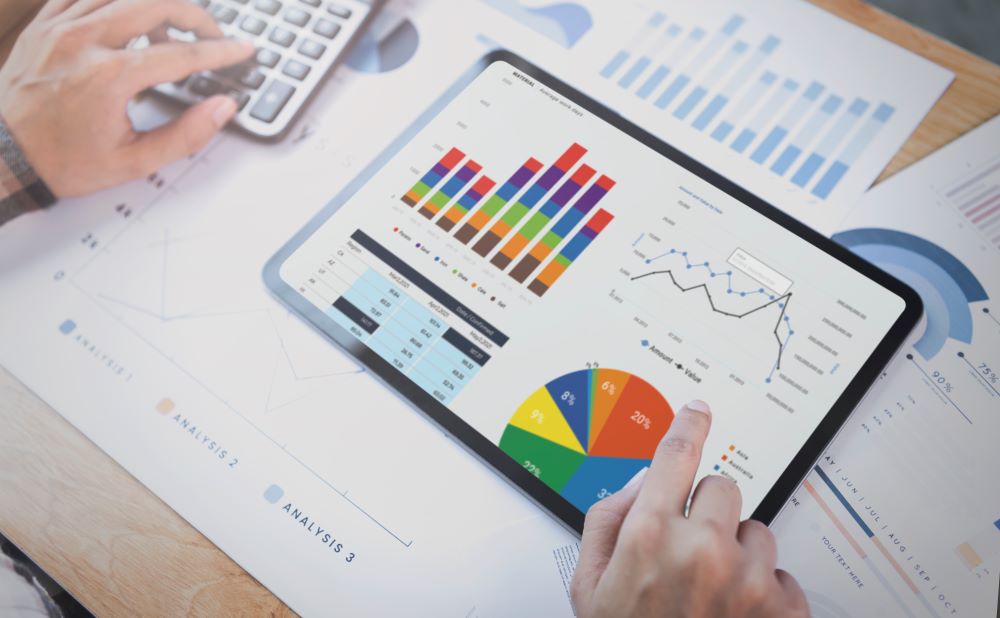The role of KPIs in project success
Monitoring KPIs, key performance indicators, is essential throughout projects. They help you to see exactly how you are progressing towards your goals and highlight any weaknesses. In this article, we'll look at why KPIs are so important, how to use them effectively and which KPIs are worth tracking.

What is a KPI?
Key Performance Indicator (KPI) means key or main performance indicator. It is a quantifiable measure of performance over time against an objective.
From sales and marketing KPIs to finance and HR, KPIs play an important role in achieving strategic goals in all areas of the business.
The meaning of KPI in project management
KPIs help project managers determine the overall performance of a project and its alignment with organisational objectives. They define project success within predefined budgets, deadlines, scope and quality levels.
KPIs create a link between strategic goals and project objectives, reducing attrition of project managers, team members, shareholders and customers.
KPIs can be used as an effective monitoring tool. Rather than waiting for the project to be completed before benchmarking, the project manager regularly measures progress against the set targets to determine whether the project is on track.

Why are KPI indicators important in project management?
Let's say your goal is to get from Budapest to Vienna. The signs will show us the way so that we don't end up in Bratislava. In project management, the key performance indicators are these signposts.
Good KPIs show that:
- How and in what direction has performance changed?
- How close or far are we to achieving our goals?
- How efficiently are we using our budget?
- How well is our strategy working?
- Which areas need more attention?
If the results from measuring the KPIs are not positive, they are used as a guide for project managers to determine where corrections are needed.
KPIs can also show existing problems and help prevent them.
However, if the results are good, they prove that the efforts are right and this motivates project leaders and teams.
How to use KPI numbers effectively in projects?
Tip #1: Make the KPI clear
When setting KPIs, you should always aim to have:
- specific
- can be measured
- Available from
- Relevant
- are time-limited
Tip #2: Choose your KPIs wisely, less is sometimes more
It is important to track only those metrics that are most relevant to the goals you have set. If we cannot explain why a particular KPI is essential, that is a good enough reason not to track it.
Always bear in mind that the more KPIs you have, the more effort it takes to report on them. Too much information also makes decision-making more difficult.
Tip #3: KPI should always include a target
Organisations that are just getting to know KPIs sometimes feel that they do not have enough historical information to assign an accurate target. However, not having a defined target adds a certain subjectivity to the measurement, we don't know exactly whether it is performing well or not. It is therefore worth choosing KPIs for which industry research or historical information can provide a reasonable estimate of the target.
Tip #4: Sometimes you have to say goodbye to a KPI
Not using a KPI in organisational or strategic decisions can be a warning sign that it is not needed. It may be that tracking a KPI takes more time and energy than it brings.
What KPI indicators should we track?
In the past, if a project was on time and on budget, it was considered a success. This is no longer the case. Although time and budget are still considered important factors, they are not the only determinants of success.
It may also be important to know, for example, whether the project has helped to achieve the objectives set and whether the amount and type of resources allocated to the project were appropriate and optimal.
There are many different types of KPIs in project management, but they can be grouped into 4 main categories.
Now let's look at some KPI indicator examples!
1. Timeliness KPIs
- Cycle time - The time needed to complete a task or activity. This is useful for repetitive tasks in a project.
- Percentage of completion on time - That is, whether or not a task will be completed by a given deadline.
- Time spent - The time spent on the project by each team member individually.
- Number of adjustments to the timetable - How many times has the team changed the completion date of the project as a whole.
- Full-time/calendar days - How much time the team spent on the project in calendar days, hours and/or full-time working days.
- Hours planned/time spent - How much time has been estimated for a project compared to the actual hours. If the time spent is different from the time planned, it indicates that the resource needs or budget have been underestimated and this may affect the schedule.
- Resource capacity - This project KPI will help you to allocate resources appropriately, determine any recruitment needs and accurately schedule the completion of the project. The number of individuals working on the project should be multiplied by the percentage of time available.
- Resource conflict - A lack of resources to complete projects, or employees working on several projects at once, can reduce efficiency. The KPIs comparing these conflicts will show whether the situation is a persistent problem or a one-off incident that needs to be addressed.
2. Budget KPIs
- Budget divergence - How much the actual budget differs from the planned budget. To monitor this KPI, it is necessary to measure how close the baseline amount of expenditure or revenue is to the expected amount.
- Budget preparation (or revision) cycle time - The time needed to prepare the budget for the organisation or project. This includes the total time taken to research, plan and reach a final agreement.
- Budget lines - These help owners and managers to track individual expenses and provide a more detailed picture of how the available funds are being spent.
- Number of budget repetitions – Number of budget versions prepared before final approval. A higher number means that more time is spent planning and finalising the budget.
- Intended value - This is the estimated cost of the work still to be done. For example, if you have a budget of 1 000 000 HUF and 30 percent of the project is still to be completed, the estimated value of the remaining work is 300 000 HUF. We can use this project KPI to compare the actual costs and adjust the budget if necessary.
- Cost performance index – We compare the planned cost of the work done so far with the amount actually spent. This is a ratio to measure the cost-effectiveness of the project. The value earned divided by the actual cost.

3. Quality KPIs
- Customer satisfaction and loyalty - Whether someone is satisfied and would return again can be effectively measured by a survey. This KPI can be used when the project is in direct contact with customers.
- Level of support - Like customer satisfaction and loyalty, it is a KPI measured by a one-question survey designed to understand brand loyalty.
- Number of errors - How often things need to be redone during the project. This means how many times something has to be reworked, which affects the budget and project schedule.
- Complaints - Do you receive complaints either from clients or from within the project about someone not doing their job?
- Exit rate - The number or percentage of team members who leave the project or organisation. If there is a high turnover in the project team, this may indicate a need to improve management and/or the working environment. This slows down projects and leads to higher costs in the long run.
4. Efficiency KPIs
- Average hourly rate - This indicator measures the effort required to complete a project, including staff salaries, benefits, office space, equipment and more. Tracking this average and comparing it to project results helps determine whether staff time was used efficiently.
- Resource profitability - Calculating the profitability of resources helps you understand whether team members' time has been used effectively. This calculation requires the average cost per hour and billing rates.
- Number of project milestones completed on time - There are different milestones within the project, and it is necessary to check that they are met on time. Also, whether the milestones have been completed and approved by the owner or buyer.
- Number of projects cancelled - Keep track of how many projects have been paused or completely deleted. The high number of cancelled projects may indicate a lack of planning and alignment of objectives, as well as an inability to take on new projects.
- Number of variation requests - Number and frequency of changes requested by the client to the agreed scope of work. Too many changes can negatively affect budget, resources, schedule and overall quality.
- Accountable occupancy – The percentage of project hours that can be billed to the client. These are related to revenue-generating, project-related tasks, while non-billable hours are typically more administrative, such as preparing and negotiating proposals.
In summary
As a project manager, we can measure the factors that make a project successful by defining KPIs. They help us to pinpoint how the work is progressing and show the weak points in the process. They offer an opportunity to identify areas that could lead to failure and correct any mistakes before it is too late. In contrast to subjective project indicators, KPIs use quantitative data to determine the status of projects, thus supporting successful projects.
f you also think it is important for you to be able to manage your team more successfully and to achieve your project goals effectively, choose from our current training courses for project managers!

 Designabc
Designabc